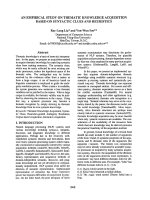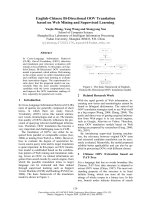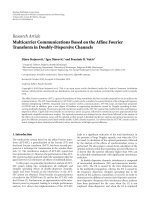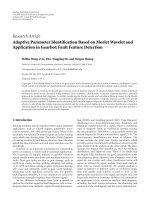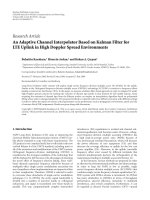Glomerular filtration rate calculation based on serum creatinin and cystatin C in type 2 diabetic patients
Bạn đang xem bản rút gọn của tài liệu. Xem và tải ngay bản đầy đủ của tài liệu tại đây (392.2 KB, 8 trang )
VNU Journal of Science: Medical and Pharmaceutical Sciences, Vol. 35, No. 2 (2019) 46-53
Original article
Glomerular Filtration Rate Calculation Based on Serum
Creatinin and Cystatin C in Type 2 Diabetic Patients
Vu Thi Thom1,*, Vu Van Nga1, Do Thi Quynh1, Nguyen Thi Binh Minh2,
Dinh Thi My Dung2, Le Ngoc Thanh1,2
1
VNUH- School of Medicine and Pharmacy, 144 Xuan Thuy, Cau Giay, Hanoi, Vietnam
2
E hospital, 89 Tran Cung, Nghia Tan, Cau Giay, Hanoi, Vietnam
Received 03 August 2019
Revised 19 September 2019; Accepted 27 November 2019
Abstract: The incidence of type 2 diabetes mellitus is rapidly increasing, with many complications
pressured on the health care system. Complications of diabetes due to chronic hyperglycemia related to
other metabolic disorders, causing damage to the microvascular system. Among them, damaged kidney
vessels lead to impair the renal function as diabetic nephropathy is the most common cause of end-stage
renal disease. Measurement of glomerular filtration rate (GFR) is an important parameter in assessing
renal function. In Vietnam’s hospital, serum creatinine is the biomarker mostly used to assess GFR.
However, this biomarker is affected many factors such as gender, age, ... Many studies showed that
serum Cystatin C is another biomarker that can detect early decline in GFR, less affected by other
factors. Therefore, we conducted this study to explore serum cystatin C and creatinine levels in patients
with type 2 diabetes and initially compare GFR in applying formulas of CKD.EPI 2012 and age and sex
factors with these two biomarkers on those patient groups. The prospective, descriptive, cross-sectional
study was performed on 50 patients with type 2 diabetes. Serum Cystatin C, serum creatinine test was
performed and GFR was estimated by CKD.EPI 2012 equation. The results showed that the average
serum Cystatin C level of the study group was 0.87 ± 0.24 mg/L that expressed no difference between
two genders, and significant difference between age groups. Whereas, the average serum creatinine level
of the study group was 81.30 ± 19.70 µmol/L, significant difference between male and female but not
difference between age groups. In patients with GFR <60 mL/min/1.73m2, serum creatinine and cystatin
C levels were higher than normal but there was no difference with the upper limit in the normal reference
range of the two indications.
Keyword: Type 2 diabetes, serum cystatin C, serum creatinine, glomerular filtration rate.
________
Corresponding author.
Email address:
/>
46
V.T. Thom et al. / VNU Journal of Science: Medical and Pharmaceutical Sciences, Vol. 35, No. 2 (2019) 46-53
1. Introduction
Nowadays, the incidence of diabetes is
rapidly increasing. According to the statistics of
the World Federation of Diabetes (2017), there
are more than 400 million people with diabetes.
It is estimated that by 2045 this number will
increase by 1.1%, equivalent to over 600 million
people. Vietnam is one of the top countries with
an estimated incidence of 2/1000 people in 2017
and an increase of 3.5/1000 people by 2045 [1].
In particular, type 2 diabetes accounts for more
than 90% of diabetic patients [2]. Progressive
diabetes causes many serious complications,
major threats to health as well as the quality of
life of patients. Complications of diabetes due to
chronic hyperglycemia associated with other
metabolic disorders, causing damage to the small
blood vessel. Microvascular complications of
diabetes
include
diabetic
nephropathy,
neuropathy and retinopathy. In particular, kidney
damage is a common complication with the rate
of 25.6% to 33.1% in Vietnam [3, 4]. Diabetic
nephropathy
causes
renal
structural
abnormalities such as hypertrophy of the
kidneys, an increase in basement membrane
thickness, hyaline of kidney’s vessels [5]. The
functional alterations include a decrease in GFR,
proteinuria, loss of kidney function [6]. GFR is
the critical renal function. In clinical practice,
estimating GFR using formulas base on serum
creatinine is the most widely used method to
assess kidney function [7]. In recent years, many
studies show the disadvantages of using serum
creatinine to measure GFR, this indicator has
poor sensitivity among mild renal dysfunctional
patients and it can be affected by other factors
such as age, gender, BMI, race, etc. [8, 9].
Therefore, many studies have been conducted to
evaluate GFR better, and cystatin C is one of the
biomarkers recommended by the American
Kidney Association to evaluate and classify
chronic kidney disease [10]. Cystatin C is a
substance produced at a constant rate by most
cells with a nucleus, a low molecular weight
protein with M = 13,359 kDa [11]. Cystatin C is
normally filtered freely through the glomerulus
and reabsorbed and metabolized in the renal
47
tubule and the renal glomeruli freely filtered it.
The renal tubules don’t excrete and only an
extremely small amount of cystatin C is excreted
in the kidneys [7]. Therefore, the serum
concentration of cystatin C is valuable to assess
GFR and is not affected by factors such as diet,
nutritional status, inflammatory state or other
malignant diseases. Cystatin C in healthy adult
ranges between 0.4-1.2 mg/L for both men and
women [12, 13]. There are many different GFR
equations, Inker et al (2012) applied the equation
to estimate GFR for 1119 subjects in 5 different
studies and showed the GFR value of the
combined formula between serum cystatin C and
creatinine are more accurate and reliable [8].
In Vietnam, there have not been many
studies evaluating the GFR based on serum
creatinine and serum cystatin C indicators, so we
conducted this study to identify some factors
such as age and gender related to serum cystatin
C and serum creatinine concentrations as well as
initial compare the GFR using the equation of
CKD.EPI2012 of these two biomarkers in type 2
diabetic patients.
2. Materials and methods
Subjects of study: Type 2 diabetes out-patients
treatment at the General Department of Internal
Medicine – E Hospital. The CKD-EPI 2012
equations were used to calculate eGFR [14].
Two groups of patients were classified based on
eGFR including eGFR<60 mL/min/1,73m2 and
eGFR>60 mL/min/1,73m2.
Selection criteria: The patient has been
diagnosed with type 2 diabetes (According to the
Guidelines of the American Diabetes
Association 2018) [15]; Full clinical information
(age, gender), subclinical information (serum
creatinine concentration, serum cystatin C
concentration, serum glucose concentration) and
voluntary participation in the study.
Exclusion criteria: The patients have one of
the following criteria: acute illness; are treating
thyroid diseases, taking thyroid medication in
the last 6 months or being treated for
corticosteroids;
48
V.T. Thom et al. / VNU Journal of Science: Medical and Pharmaceutical Sciences, Vol. 35, No. 2 (2019) 46-53
Time and place of study: The study was
carried out from August 2018 to January 2019,
data were collected from the Department of
Biochemistry and Department of General
Internal Medicine - E. Hospital.
Study methods: prospective, descriptive,
cross-sectional study
Patients were examined and blood sampling
for biochemical test. Serum Creatinine tests used
Jaffee method with Olympus reagent
(Germany), and serum Cystatin C test used
turbidity measurements with Dialab reagent
(Austria), both were performed on AU680
(Beckman Coulter, American) at the Department
of Biochemistry of E. Hospital
Reference interval of two indicators [12,13]:
Serum Creatinine: man 74-110 µmol/L
woman: 58-96 µmol/L
Serum Cystatin C: 0.4-1.2 mg/L
Statistical analysis: Data were analyzed by
SPSS 22.0 software (IBM, American). Analysis
of variance (ANOVA); Chi-square tests (χ2) and
Pearson correlation were applied to the
corresponding cases, Student’s t-test was used to
compare the means between two groups. P-value
of less than 0.05 was considered as a statistically
significant difference.
3. Results
Serum cystatin C and serum creatinine level
The results of serum cystatin C and serum
creatinine level in two gender groups were
showed in table 1:
Table 1. Serum cystatin C and serum Creatinine levels in two genders
Indicator
Serum Cystatin C (mg/L)
Serum Creatinine (mmol/L)
Man
(𝑥̅ ± SD)
0.92 ± 0.25
92.00 ± 19.36
Men had higher serum creatinine levels than
women, while there was no difference in serum
cystatin C level in both genders. This is similar
to the study of Weinert LS et al. (2010). This
study performed on 97 healthy volunteers aged
18-40 years, 44% are men, the result showed that
gender had no effect on serum cystatin C level
while there was a clear difference in creatinine
levels in two genders (p = 0.001) [16]. In
Vietnam, the study of Nguyen Thi Ly and Tran
Thi Chi Mai (2012) on 90 patients with type 2
Woman
(𝑥̅ ± SD)
0.83 ± 0.23
74.23 ± 16.79
Mean for all
(𝑥̅ ± SD)
0.87 ± 0.24
81.30 ± 19.70
p
0.199
0.01
diabetes also showed no difference in cystatin C
levels in both sexes [17]. Research on 3 groups
of patients: with diabetes, thyroid and
cardiovascular disease of Musaimi (2019) also
found no difference in cystatin C concentration
in both sexes. This research also showed that
cystatin C is a useful biomarker for these
diseases [18].
Relationship between serum creatinine,
serum cystatin C level and age
Table 2. Serum Cystatin C and Creatinine levels in age groups
Age group
Serum cystatin C level (mg/L)
(𝑥̅ ± SD)
<60
61-70
>70
p
0.701±0.089
0.847±0.191
1.046±0.286
<0.001
Serum creatinine
level (µmol/L)
Man
(𝑥̅ ± SD)
Woman
n=5
75.700±16.177
n=8
69.975±9.218
n=9
96.867±20.729
n=13
69.146±7.829
n=6
98.217±13.131
n=9
85.378±25.603
0.088
0.053
V.T. Thom et al. / VNU Journal of Science: Medical and Pharmaceutical Sciences, Vol. 35, No. 2 (2019) 46-53
Many studies showed that aging increases
kidney problems [19,20]. To analyze the
relationship between age and serum cystatin C
levels, we divided our patients into three age
groups: <60, 61 - 70, >70-year-old. In each age
group, we analyzed the concentration of serum
cystatin C and serum creatinine, the results were
shown in Table 2.
The results showed that serum Cystatin C
levels increased with age (p<0.001) and serum
creatinine levels wasn’t different between age
groups (p = 0.088 in man, p = 0.053 in woman).
The patients in our study were more than 40
years old. In this age, the physiological function
tended to decrease, the ability to filter Cystatin C
decreased, leading to an increase in serum
Cystatin C level. This occurs because the
kidneys also suffer from aging damage - a
natural biological process [19]. Vascular disease
affects the blood vessels in the kidneys, the loss
of nephrons and the gradual decline of the
cellular functions. All of these reasons can lead
to renal tubular damage, decrease of GFR and
increase the concentration of cystatin C in the
blood.
Many studies showed that with age, there is
a reduce in size and number of nephrons,
49
changing tubulointerstitial and increasing
glomerulosclerosis [20]. Thus, the increase of
serum cystatin C concentration with age may be
the result of physiological decrease GFR.
With increasing age, there is the decrease in
the function of kidney so that serum creatinine
level increases. Other way, increasing age also
decrease in muscle mass which also reduces the
creatinine production. Thus, when the age
increases, serum creatinine level usually does
not respond timely with the degree of
impairment kidney function [21]. After
analyzing the relationship between these two
indicators and age, we found that cystatin C was
more valuable than creatinine in assessing the
degree of renal physiological impairment with
age.
Classification serum creatinine level and
serum cystatin C levels by the three CKD-EPI
equations
According to the classification of KDIGO,
the GFR below 60 mL/min/1.73m2 is considered
as reducing and kidney start to be damaged [14].
Classification the patients by GFR, we had the
results of serum creatinine level and serum
cystatin C level in table 3.
Table 3. Serum cystatin C level and serum creatinine level classify according to the equation GFRCre, GFRcys,
GFRcys-cre
Indicator
GFR group
Classify
according to the
equation GFRcre
Classify
according to the
equation GFRcys
Classify
according to the
equation GFRcys-
p
Serum cystatin C
level
(mg/L)
GFR<60
mL/min/1,73m2
GFR>60
mL/min/1,73m2
(n=8)
1.178±0.247
(n=42)
0.809±0.193
(n=8)
1.287±0.213
(n=42)
0.789±0.146
(n=7)
1.295±0.231
(n=43)
0.799±0.159
0.542
GFR<60
mL/min/1,73m2
GFR>60
mL/min/1,73m2
GFR<60
mL/min/1,73m2
GFR>60
mL/min/1,73m2
(n=3)
125.133±14.425
(n=17)
86.129±13.286
(n=5)
99.560±27.603
(n=25)
69.172±7.299
(n=4)
115.225±20.299
(n=16)
86.169±14.565
(n=4)
103.225±30.435
(n=26)
69.777±7.788
(n=3)
120.200±21.669
(n=17)
87.000±14.513
(n=4)
100.800±31.711
(n=26)
70.150±8.718
0.801
cre
(𝑥̅ ± SD)
Serum
creatinine
level
(µmol/L)
Man
(𝑥̅ ± SD)
Woman
0.849
0.980
0.983
0.907
50
V.T. Thom et al. / VNU Journal of Science: Medical and Pharmaceutical Sciences, Vol. 35, No. 2 (2019) 46-53
Patients with GFR <60 mL/min/1.73m2 had
higher serum creatinine and serum cystatin C
levels than the remaining patients and higher
than the upper limit normal. If the GFR number
was low, the kidney function was not well.
Reducing the capacity of glomerular filtration
make many substances stagnate so the
concentration of these substances in blood
increases. Thus, the concentration of serum
creatinine and serum cystatin C were high in the
lower GFR group. This result agreed with the
result of Oddoze et al. (2001) [22].
Table 3 showed that serum cystatin C level
in patients with GFR<60mL/min/1.73m2 was not
different when calculated by 3 GFR equations.
The results were similar with patients with
GFR> 60mL/min/1.73m2 and with serum
creatinine level in two groups of GFR. Besides,
we found that patients with GFR <60
mL/min/1.73m2 had the serum creatinine level and
serum cystatin C levels higher than the normal
reference range of these two indicators.
Serum creatinine level and serum cystatin
C level in patients with GFR <60mL
/min/1.73m2 compared with normal reference
range
There was no difference in serum creatinine
levels and serum cystatin C levels using 3
equations. Thus, we chose to compare these two
markers with the upper limit of each indicator in
patients with GFR<60mL/min/1.73m2 when
using the GFRcys-cre equation (The equation
that uses both of these indicators). The results
were shown in Table 4.
Table 4. Comparison serum cystatin C and serum creatinine levels with reference upper range in patients with
GFR <60mL/min/1.73m2 according to GFRcys-cre equation
Indicators
Serum cystatin C level (mg/L)
Man
Serum creatinine
level (µmol/L)
Woman
Mean
(𝑥̅ ± SD)
1.295 ± 0.231
120.200 ± 21.669
100.800 ± 31.711
From the results of Table 4, we found that in
the group patients with GFR <60
mL/min/1.73m2 according to GFRcys-cre equation,
serum cystatin C and serum creatinine levels
increased but has no significant difference with
the upper limit of the normal reference range of
these two indices. Thus, we have not found a
difference in the changes in serum cystatin C and
creatinine levels in patients with GFR
<60mL/min/1,73m2. This result was in line with
the study of Oddoze et al. (2001). These authors
also identified that serum cystatin C did not
outperform serum creatinine methods to detect
kidney damage [22]. A limitation in our study is
that we only research on diabetic patients with a
small number of patients, the results may not
apply to patients with kidney damage due to
other causes.
Upper limit of
normal
1.2 mg/L
110 µmol/L
96 µmol/L
p
0.318
0.501
0.782
4. Discussion
Serum cystatin C and serum Creatinine
levels in two genders
Men had higher serum creatinine levels than
women, while there was no difference in serum
cystatin C level in both genders. This is similar
to the study of Weinert LS et al. (2010). This
study performed on 97 healthy volunteers aged
18-40 years, 44% are men, the result showed that
gender had no effect on serum cystatin C level
while there was a clear difference in creatinine
levels in two genders (p = 0.001) [16]. In
Vietnam, the study of Nguyen Thi Ly and Tran
Thi Chi Mai (2012) on 90 patients with type 2
diabetes also showed no difference in cystatin C
levels in both sexes [17]. Research on 3 groups
of patients: with diabetes, thyroid and
cardiovascular disease of O.Al Musaimi (2019)
also found no difference in cystatin C
V.T. Thom et al. / VNU Journal of Science: Medical and Pharmaceutical Sciences, Vol. 35, No. 2 (2019) 46-53
concentration in both sexes. This research also
showed that cystatin C is a useful biomarker for
these diseases [18].
Relationship between serum creatinine,
serum cystatin C level and age
The patients in our study were more than 40
years old. In this age, the physiological function
tended to decrease, the ability to filter Cystatin C
decreased, leading to an increase in serum
Cystatin C level. This occurs because the
kidneys also suffer from aging damage - a
natural biological process [19]. Vascular disease
affects the blood vessels in the kidneys, the loss
of nephrons and the gradual decline of the
cellular functions. All of these reasons can lead
to renal tubular damage, decrease of GFR and
increase the concentration of cystatin C in the
blood.
Many studies showed that with age, there is
a reduce in size and number of nephrons,
changing tubulointerstitial and increasing
glomerulosclerosis [20]. Thus, the increase of
serum cystatin C concentration with age may be
the result of physiological decrease GFR.
With increasing age, there is the decrease in
the function of kidney so that serum creatinine
level increases. Other way, increasing age also
decrease in muscle mass which also reduces the
creatinine production. Thus, when the age
increases, serum creatinine level usually does
not respond timely with the degree of
impairment kidney function [21]. After
analyzing the relationship between these two
indicators and age, we found that cystatin C was
more valuable than creatinine in assessing the
degree of renal physiological impairment with
age.
Classification serum creatinine level and
serum cystatin C levels by the three CKD-EPI
equations
Patients with GFR <60 mL/min/1.73m2 had
higher serum creatinine and serum cystatin C
levels than the remaining patients and higher
than the upper limit normal. If the GFR number
is low, the kidney function is not well. Reducing
the capacity of glomerular filtration make many
51
substances stagnate so the concentration of these
substances in blood increases. Thus, the
concentration of serum creatinine and serum
cystatin C are high in the lower GFR group. This
result is similar to the result of Oddoze et al.
(2001) [22].
Table 4 shows that serum cystatin C level in
patients with GFR<60mL/min/1.73m2 is not
different when calculated by 3 GFR equations.
The results were similar with patients with
GFR> 60mL/min/1.73m2 and with serum
creatinine level in two groups of GFR. Besides,
we found that patients with GFR <60
mL/min/1.73m2 had the serum creatinine level
and serum cystatin C levels higher than the
normal reference range of these two indicators
Serum creatinine level and serum cystatin
C level in patients with GFR <60mL
/min/1.73m2 compared with normal reference
range
From the results of Table 5, we found that in
the group patients with GFR <60
mL/min/1.73m2 according to GFRcys-cre equation,
serum cystatin C and serum creatinine levels
increased but has no significant difference with
the upper limit of the normal reference range of
these two indices. Thus, we have not found a
difference in the changes in serum cystatin C and
creatinine levels in patients with GFR
<60mL/min/1,73m2. This result is similar to the
study of Oddoze et al. (2001). These authors also
identified that serum cystatin C did not
outperform serum creatinine methods to detect
kidney damage [22]. A limitation in our study is
that we only research on diabetic patients with a
small number of patients, the results may not
apply to patients with kidney damage due to
other causes.
5. Conclusions
Serum Cystatin C level in our patients
depended on age where serum creatinine level
depended on gender. Serum cystatin C was more
valuable than serum creatinine in assessing the
degree of renal physiological impairment with
52
V.T. Thom et al. / VNU Journal of Science: Medical and Pharmaceutical Sciences, Vol. 35, No. 2 (2019) 46-53
age. Calculation of GRF based on serum cystatin
C level or serum creatinine level or combine of
both was not significant different in this study.
[7]
Acknowledgements
We would like to thank the sponsorship of
the School of Medicine and Pharmacy, Vietnam
National University, Hanoi for the project code
CS.18.05; Thanks to the staffs of the School of
Medicine and Pharmacy, VNU-Hanoi and E
Hospital for supporting and facilitating us to
carry out this study.
[8]
[9]
References
[1] N.H. Cho, J. Kirigia, J.C. Mnanya, K. Ogurstova,
L. Gủaiguata, W. Rathmann, G. Roglic, N.
Forouhi, R. Dajani, A. Esteghmati, E. Boyko, L.
Hambleton, O.L.M. Neto, P.A. Montoya, S. Joshi,
J. Chan, J. Shaw, T.A. Samuels, M. Pavkov, A.
Reja, IDF Diabetes Atlas eight edition,
International
Diabete
Federation,
2017.
(access 15
july 2019).
[2] G. Xu, B. Liu, Y. Sun, Y. Du, L.G. Snetselaar, F.B.
Hu, W. Bao, Prevalence of diagnosed type 1 and
type 2 diabetes among US adults in 2016 and 2017:
population based study, British Medical Journal
361
(2018)
k1497.
/>10.1136/bmj.k1497.
[3] N.T.T. Minh, N.K. Luong, N.K. Son, The clinical
and subclinical characteristics in patients with
diabetes mellitus treated at Thai Nguyen General
hospital, Journal of pratical medicine 787 (2011)
25-8.
[4] N.T.H. Lan, L.D. Tuan, Survey characteristics of
renal complication in elderly type 2 diabetes
outpatients treated at National Hospital of
Endocrinology, Journal of Military Pharmacomedicine 6 2017 55-62.
[5] Mohsen Pourghasem, Hamid Shafi, Zahra,
Histological changes of kidney in diabetic
nephropathy, Caspian J Intern Med 6(3) (2015)
120-7.
/>650785/pdf/cjim-6-120.pdf (access 16 july 2019).
[6] D.W. Powell, D.N. Kenagy, S. Zheng, S.C.
Coventry, J. Xu, L. Cai, E.C. Carlson, P.N. Epstein,
[10]
[11]
[12]
[13]
[14]
[15]
Associations between Structural and Functional
Changes to the Kidney in Diabetic Humans and
Mice, Life Sci 93(7) (2013) 257-64. />10.1016/j.lfs.2013.06.016.
Natalie Ebert, Elke Schaeffner, New biomarkers
for estimating glomerular filtration rate, Journal of
Laboratory and Precision Medicine 3(75) (2018.
/>L.A. Inker, C.H. Schmid, H. Tighiouart, J.H.
Eckfeldt, H.I. Feldman, T. Greene, J.W. Kusek, J.
Manzi, F.V. Lente, Y.L. Zhang, J. Coresh, A.S.
Levey, Estimating Glomerular Filtration Rate from
Serum Creatinine and Cystatin C, The new
England Journal of Medicine 367 (2012) 20-9.
10.1056/NEJMoa1114248.
Ashwin Kumar, Anil Kumar, Serum cystatin C and
serum creatinine levels in type 2 diabetes mellitus,
International Journal of Research in Medical
Sciences 3(1) (2015) 174-7.
/>X. Jianguo, D.I. Broadhurst, M. Wilson, D.S.
Wishart, Translational biomarker discovery in
clinical metabolomics:an introductory tutorial,
Metabolomics 9 (2013) 280–99. />10.1007/s11306-012-0482-9.
B.T. Anh, Estimate the glomerular filtration rate by
plasma creatinine and cystatin C concentration,
Journal of Vietnam Medicine 2 (2012) 12-18.
S. Kakde, S. Alexander, V.G. David, S. Jacob, A.
Mohapatra, A.T. Valson, B. Gopal, C.K. Jacob, J.
Hephzibah, V. Tamilarasi, S. Varughese,
Relationship of creatinine and cystatin C-based
estimated glomerular filtration rates with measured
glomerular filtration rate in healthy kidney donors
from South Asia, Indian J Nephrol 28 (2018) 34550. 0.4103/ijn.IJN 249_17
Olympus life science research europa GmbH,
Olympus clinical chemistry reagent guide,
Olympus Diagnostic, American, 2009.
International Society of Nephrology, KDIGO 2012
clinical practice guideline for the evaluation and
Management of chronic kidney disease, Kidney
Int, Kidney International Supplements 3(1) (2012)
5-14.
/>L.pdf (access 19 july 2019).
American Diabete Association, Classification and
Diagnosis of Diabetes: Standards of Medical Care
in Diabetes 2018. Diabetes Care, (41(Supplement
1)) (2018) S13-S27. (access 18 july 2019).
V.T. Thom et al. / VNU Journal of Science: Medical and Pharmaceutical Sciences, Vol. 35, No. 2 (2019) 46-53
[16] L.S. Weinert, A.B. Prates, F.B. do Amaral, M.Z.
Vaccoro, J.L. Camargo, S.P. Silveiro, Gender does
not influence cystatin C concentrations in healthy
volunteers, Clin Chem Lab Med 48(3) (2010) 4058. />[17] N.T. Ly, T.T.C. Mai, Serum cystatin C and renal
function in type 2 diabetic patients, Journal of
medical Research 80(3B) (2012) 17-O.Al.
[18] Musaimia, A.H. Abu-Nawwas, D.Al. Shaera,
N.Y.Khaleela, M.Fawzi, Influence of age, gender,
smoking, diabetes, thyroid and cardiac
dysfunctions on cystatin C biomarker, Medicina de
Familia Semergen 45(1) (2019) 44-51.
10.1016/j.semerg.2018.07.005.
[19] M.C. Odden, I.B. Tager, R.T. Gansevoort, S.J.L.
Bakker, R. Katz, L.F. Fried, et al, Age and cystatin
C in healthy adults: a collaborative study, Nephrol
53
Dial
Transplant
25(2)
(2010)
463-9.
/>[20] E.D. O’ Sullivan, J. Hughes, D.A. Ferenbach,
Renal Aging: Causes and Consequences, J Am Soc
Nephrol 28 (2017) 407–20.
/>[21] E.D. O’ Sullivan, J. Hughes, D.A. Ferenbach,
Renal Aging: Causes and Consequences, J Am Soc
Nephrol 28 (2017) 407–20.
/>[22] Christiane Oddoze, Henri Portugal, Yvon Berland,
Bertrand Dussol, Cystatin C Is Not More Sensitive
Than Creatinine for Detecting Early Renal
Impairment in Patients With Diabetes. American
Journal of Kidney Diseases, 38(2 (August)), (2001)
310-6. 10.1053/ajkd.2001.26096.


